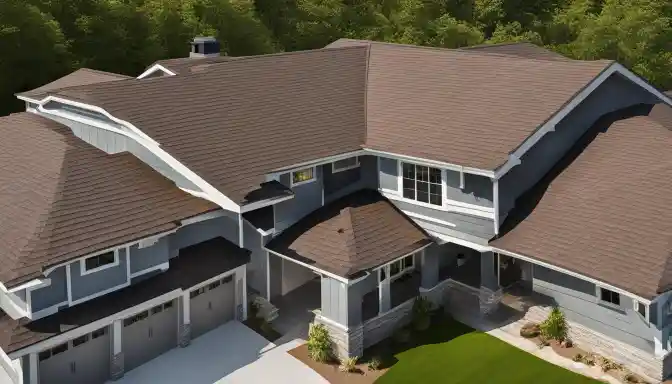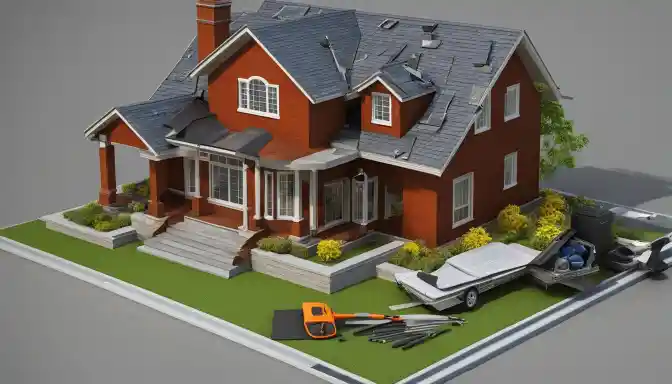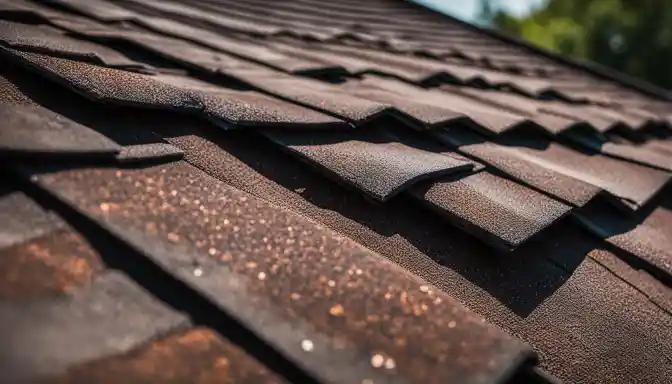When it’s time to tackle residential roof replacement, the swirl of information can leave you grappling with more questions than answers. Discussing the average cost of a new roof is one thing, but understanding the full context behind roof replacement expenses is entirely another. It’s critical to unravel the factors that steer these costs, from the sheer scope of your roof renovation project to the choices that lie in the materials and workmanship. In your home improvement journey, it’s not merely about replacing what’s above; it’s about investing wisely in the shelter that protects your everyday life.
Whether you’re examining leaking corners or planning to refresh your home’s aesthetic, the stakes are high—and so might be the roof renovation costs. But fear not; we are here to guide you through this crucial financial decision with ease. With a comprehensive grasp of the numerous elements influencing the final bill—from the pitch of your abode to the quality of materials—you can prepare to navigate this complex terrain. Let’s demystify the details and sprinkle clarity on the enigma that is the cost of replacement roofs.
Key Takeaways
- Roof size, shape, and design intricacies impact the labor required and the roof replacement expenses.
- Material quality dramatically influences the overall cost, with a vast range from budget-friendly options to premium aesthetics and longevity.
- Geographical factors and regional cost of living can significantly sway the average cost of a new roof.
- Additional necessities such as permits, insurances, and disposal fees are pivotal to your roof renovation budget.
- Understanding cost variances tied to complexities and material choices empowers you to make informed decisions that align with your financial outlook.
Understanding Roof Replacement Expenses
When planning for a roof replacement, it’s critical to conduct a thorough cost analysis of roof replacement to set realistic expectations for your budget. The final figure is influenced by a multitude of factors, including roofing labor costs, roof size and replacement cost, and the roofing material prices. In this section, we’ll delve into what constitutes the bottom line and highlight cost-effective roofing options to ensure you make a well-informed decision.

Factors Influencing Roofing Cost Factors
The blueprint of your project begins with understanding the roofing cost per square foot, which varies depending on the complexity of the job. A straightforward gable roof will have different labor and material demands than a complex multi-pitched roof with dormers or skylights. Besides the architectural intricacies, the expense of roofing is also shaped by the roof lifespan and cost, dictating how often you’ll need to invest in a new roof.
Size and Complexity: Average Cost and Variations
It’s not just about the total square footage; it’s how that space is arranged and accessed that can boost your roofing quote. Larger roofs may offer a reduced roofing cost per square foot leveraging economies of scale. However, additional levels or hard-to-reach areas necessitate scaffolding and safety equipment, influencing the roofing labor costs. The height and accessibility of your roof are just another piece of the comprehensive cost analysis of roof replacement you need to consider.
Materials Matter: Comparing Roofing Material Prices
The selection of roofing materials has one of the most significant impacts on your final bill. From the ubiquitous asphalt shingle roof costs to the premium price tag of metal roof replacement costs or the elegance of slate tiles, your choice reflects both in upfront expenditure and long-term value. Let’s break down the costs associated with some common roofing materials:
| Material | Cost Per Square Foot | Lifespan |
|---|---|---|
| Asphalt Shingles | $4.25 | 20-30 years |
| Metal Roofing | $10.00 – $39.70 | 40-70 years |
| Slate Tiles | Upwards of $39.70 | 100+ years |
| Clay Tiles | $12.00 – $25.00 | 50+ years |
As seen, the cost of roof tiles can significantly exceed that of simpler materials like asphalt shingles, but they also offer a considerably longer roof lifespan, which could mean cost savings over time. Beyond the upfront roof installation costs, thinking about the longevity and durability of your chosen material—aspects central to cost of durable roofing—is vital for a comprehensive cost consideration.
- Cost-effective Roofing Options: While higher-end materials might seem costly, their extended lifespan and often lower maintenance requirements can translate into long-term savings.
- Roof Remodeling Costs: If you’re including additional elements such as solar panels or skylights, this will alter the initial estimate.
Recognizing the complex nature of roof remodeling costs is essential for proper financial planning. Addressing each factor from the material to labor and the structural specifics of your property ensures that your investment into a new roof yields the best possible return.
Cost of Replacement Roof: Calculating Your Investment
As you gear up for a major home improvement, understanding the roof replacement budget and the myriad of components that it entails becomes vital. Not only will you need to consider the roof replacement estimates and quotes, but also the nuances that impact the final price. Our roofing price guide is designed to arm you with knowledge for informed decision-making tailored to your roofing project.
Realistic Roof Replacement Budget Considerations
Before obtaining roof replacement quotes, it’s essential to reflect on your budgeting for roof replacement strategy. This involves a comprehensive look at all potential roofing project expenses. Always factor in not just the baseline roof installation costs, but also the residential roofing cost guide towards eco-friendly or energy-efficient roofs. Additionally, prepare for roofing labor costs and roof replacement labor rates, which play a significant role in your budget.
Geographical Impact on Roofing Project Expenses
Geographical location roofing costs can fluctuate depending on the local economy and weather patterns. Areas subjected to severe conditions will inevitably reflect higher material and labor costs. Your local roofing cost comparison should include these geographical-based pricing dynamics to ensure effective cost planning.
Roofing Labor Costs: Calculating The Numbers
Understanding the complexities of roofing labor costs is crucial. It is more than just tallying hours; it encompasses the intricacy of labor, which is influenced by the roof’s design, pitch, and size. High demand and skilled labor could inflate your roof replacement planning costs, which is why thorough research is needed to identify the appropriate roof replacement labor rates in your area.
Hidden Costs: Insurance and Permits
Oftentimes, the hidden costs in roof replacement can catch homeowners off-guard. These can include mandatory roof replacement insurance costs and local roofing permits required by your municipality. It’s imperative to acquire a detailed roof replacement cost breakdown to anticipate these expenses.

For a more granular look at budgeting scenarios for a roof replacement, consider the table below:
| Component | Average Cost | Notes |
|---|---|---|
| Materials | $100 – $1,000 per square | Varies by material type and quality |
| Labor | About $60 per hour | Depends on complexity and region |
| Disposal Fees | $50 – $250 | Based on local regulations and dumpster rental |
| Permits | $150 – $500 | Vary according to local building codes |
| Additional Repairs | Variable | Cost increases with unexpected structure damage |
| Eco-Friendly Upgrades | Additional 20-30% | Long-term savings offset initial costs |
Keep in mind that the numbers above are estimates and may represent a roof replacement price range that can vary based on your specific circumstances. A conscientious approach to budgeting will help you plan for both the seen and unseen, thereby ensuring a smoother roofing venture.
Conclusion
Embarking on the journey of a roof replacement is to understand the significant weight of the investment ahead. In grappling with the myriad factors that shade the final tally, including materials, labor, geographic considerations, and the sometimes unpredictable complexities of the task—you, as a homeowner, must employ precision in calculating roof replacement costs. Indeed, this careful accounting will enable you to set aside the necessary resources to guarantee that the roof over your head is not just a shelter but a wise financial commitment.
Whether it’s replacing an outdated roof or addressing structural damage, roof upgrade costs hinge on a blend of strategic planning and thorough research. Reflecting on the cost of roof removal alongside the price of new materials and the labor to install them offers a more complete picture of what your home improvement venture will entail. Yet, beyond the digits that comprise the bottom line is the value a new roof adds to your residence. The roof replacement value is evident through enhanced curb appeal, improved energy efficiency, and fortified protection against the elements.
Ultimately, your roof stands as a guardian of your domestic comfort, and investing in its care is a testament to its importance. With a nuanced grasp of what drives roof-related finances, you are better positioned to navigate this substantial undertaking with confidence. Remember, a roof is more than just an assembly of shingles and nails; it’s a critical investment in the integrity and longevity of your home.
FAQ
What factors should I consider when estimating my roof replacement expenses?
When estimating roof replacement expenses, consider factors such as the roof’s size, complexity, materials, labor costs, geographical location, permit fees, the cost of roof removal, and any additional features like enhanced insulation or eco-friendly materials.
How does the size and complexity of my roof affect the average cost of a new roof?
Larger and more complex roofs require more materials and labor, which will increase the overall cost. Features like multiple levels, valleys, and gables make installation more complex, thus affecting the average cost of a new roof.
Why do roofing material prices vary, and how do they impact my roof renovation costs?
Roofing material prices vary based on durability, aesthetic appeal, and energy efficiency. Materials like asphalt shingles are generally more affordable, while slate or metal roofing can be more expensive. Your choice of material will significantly impact the overall roof renovation costs.
Can you explain how the roof replacement cost factors into the long-term value of my home?
A new roof can increase your home’s value by improving curb appeal, energy efficiency, and protection against the elements. Strong, durable roofing may also result in lower maintenance costs over time, adding to the long-term value of your investment.
What budget considerations are essential for a realistic roof replacement estimate?
For a realistic estimate, consider the cost of materials, labor, roof removal, and disposal. Don’t forget to factor in potential costs for additional repairs, upgrades, permits, and insurance, as well as any necessary structural changes like reinforcing the framing or improving ventilation.
How does my geographical location influence the cost of my roofing project?
Your location can affect costs due to factors like local weather conditions requiring specific materials, different cost of living influencing labor rates, and variable local permit fees. Also, accessibility to your property and roof can vary by location, impacting labor costs.
How do I calculate roofing labor costs effectively?
To calculate roofing labor costs, consider the complexity of your roof, the going hourly rate or per-square-foot rate for skilled laborers in your area, the estimated time required to complete the project, and any additional expenses for project management and insurance.
What are some hidden costs I should be aware of when replacing my roof?
Hidden costs in roof replacement can include higher insurance premiums for your contractor, permit fees, unexpected structural repairs, removal, and disposal of the old roofing materials, and upgrades necessary to meet current building codes. Considering these factors upfront can prevent surprise expenses.
Is it worth investing in eco-friendly or energy-efficient roofing options?
Eco-friendly or energy-efficient roofs can be more expensive initially, but they can offer significant long-term savings. Reduced energy consumption, potential tax credits, and extended durability are just a few benefits that can offset the higher upfront costs over time.
Should I anticipate any additional renovation costs when planning for a new roof?
Yes, it’s prudent to anticipate additional renovation costs such as updates to your home’s insulation, gutter system, or potential repairs to the underlying roof structure. Thorough inspections before the replacement can help you gauge these potential costs more accurately.






